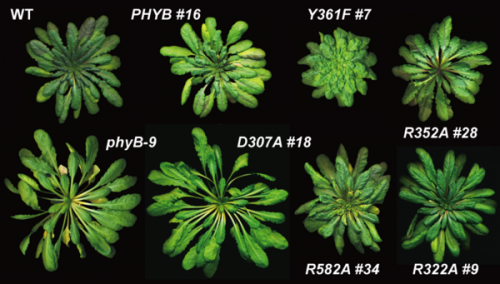Tricking plants to see the light may control the most important twitch on Earth

Copious corn growing in tiny backyard plots? Roses blooming in December? Thanks to technology that the University of Wisconsin-Madison's Richard Vierstra has been developing for years, these things may soon be possible. And now, new findings out of the genetics professor's lab promise to advance that technology even further.
For the first time, Vierstra and his team have revealed the structure of the plant phytochrome, a critical molecule that detects the light that tells plants when to germinate, grow, make food, flower and even age. Like eyes, the phytochrome is a light sensor that converts sunlight into chemical signals to get these jobs done. By manipulating it, the group can alter the conditions under which all plants grow and develop.
Vierstra's group published the structure in a recent issue of the journal Proceedings of the National Academy of Science. His team also presented its results this month at the annual meeting of the American Society of Plant Biologists in Portland, Oregon.
"It's the molecule that tells plants when to flower," says Vierstra. "Plants use the molecule to sense where they are in the canopy; they use the phytochromes for color vision—to sense whether they are above, next to or under other plants."
Vierstra previously determined the structure of a similar phytochrome from light-sensing bacteria, which guided his work in plants. He already has several patents on the technologies derived from these structures and has been in talks to commercialize them. The determination of a plant phytochrome three-dimensional structure will only accelerate improvements to the technology.
One of the biggest moves in agriculture, Vierstra says, is to be able to grow plants at higher density, allowing producers to plant more crops in a given area, thus saving space and other resources.
Currently, there is a limit to how closely plants can grow relative to their nearest neighbors. At high density, the leaves of one plant shade the other, signaling to the shaded plant it isn't receiving enough sunlight. These plants grow stems and stalks rather than fruits and seeds, becoming long and leggy as they reach for the sky.
That process begins with the phytochrome, which senses the wavelength of light shining on plants. Plants in full sun absorb red light while shaded plants receive only the leftover, far-red light. The type of light the phytochrome "sees" tells the plant whether to stretch out and become taller or to flower and make fruit. Based on the light available, the phytochrome cycles between an inactive and active state.
"Photoconversion between the active and inactive states of phytochromes is arguably the most important twitch on this planet, as it tells plants to become photosynthetic and consequently make the food we eat and the oxygen we breathe," says Vierstra.
Vierstra and his team found that by making specific changes to the light sensor, they can dupe it into staying in its active state longer.
"By mutating the phytochromes, we created plants that think they're in full sun, even when they're not," Vierstra says.
Three decades ago, while a postdoctoral researcher at UW-Madison, Vierstra was the first to purify the phytochrome protein. Now, his work has come full circle. He hopes the research team's findings become the scaffold for a toolkit others can use—one that might fundamentally alter agriculture.
In addition to growers, the research also has implications for other scientists, as the technology could be used to create new fluorescent molecules for detecting minuscule events inside cells, and in the field of optogenetics, which uses light as a tool to drive biological change.
Journal information: Proceedings of the National Academy of Sciences
Provided by University of Wisconsin-Madison




















